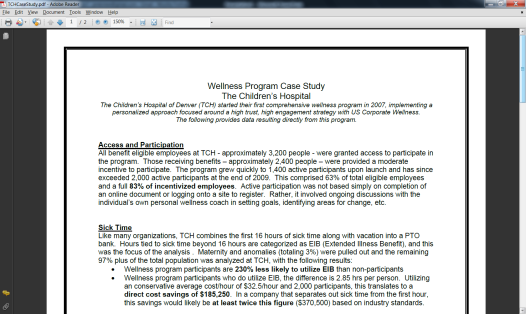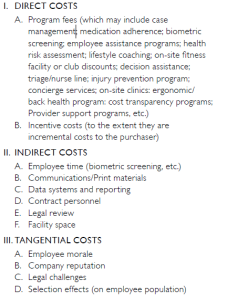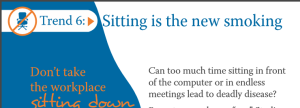Alice laughed: “There’s no use trying,” she said. “One can’t believe impossible things.”
“I daresay you haven’t had much practice,” said the Queen. “When I was younger, I always did it for half an hour a day. Why, sometimes I’ve believed as many as six impossible things before breakfast.”
Six impossible things before breakfast? The wellness industry would just be getting warmed up by believing six impossible things before breakfast. Wellness vendors believe enough impossible things all day long to support an entire restaurant chain:

Consider the article in the
current issue of BenefitsPro — forwarded to me by many members of the Welligentsia — titled: “Can the Wellness Industry Live Up to Its Promises?” BenefitsPro interviewed US Corporate Wellness, Fitbit, Staywell and
HERO. Each is a perennial candidate for the
Deplorables Awards — except US Corporate Wellness, which already
secured its place in the Deplorables Hall of Fame (see,
Why Nobody Believes the Numbers) several years ago with these three paeans to the gods of impossibility.

In case you can’t read the key statistic — the first bullet point — it says: “Wellness program participants are
230% less likely to utilize EIB (extended illness benefit) than non-participants.” Here is some news for the Einsteins at US Corporate Wellness: You can’t be 230% less likely to do anything than anybody. For instance, even you, despite your best efforts in these three examples, can’t be 230% less likely to have a triple-digit IQ than the rest of us. Here’s a rule of math for you: a number can only be reduced by 100%. Rules of math tend to be strictly enforced, even in wellness. So the good news is, even in the worst-case scenario, you’re only 100% less likely to have a triple-digit IQ than the rest of us.
See also: 6 Pitfalls to Avoid With Core Systems
And yet, if it were possible to be 230% dumber than the rest of us, you might be. For instance, US Corporate Wellness also brought us this estimate of the massive annual savings that can be obtained just by,
Seinfeld-style, doing nothing:

Assume I spent about $3,500/year in healthcare 12 years ago, which is probably accurate. My modifiable risk factors were zero then and are still zero — no increase. So my healthcare spending should have fallen by $350/year for 12 years, or $4,200 since then. But that would be impossible, because I could only reduce my spending by $3,500. Do you see how that works now?
To his credit, US Corporate Wellness’s CEO, Brad Cooper, is quoted in this article as saying: “Unfortunately some in the industry have exaggerated the savings numbers.” You think?
I’m pretty sure this next one is impossible, too. I say “pretty sure” because I’ve never been able to quite decipher it, English being right up there with math as two subjects that apparently frustrated many a wellness vendor’s fifth grade teacher:

400% of what? Is US Corporate Wellness saying that, as compared with employees with a chronic disease like hypertension, employees who take their blood pressure pills are 400% more productive? Meaning that, if they controlled their blood pressure, waiters could serve 400% more tables, doctors could see 400% more patients, pilots could fly planes 400% faster? Teachers could teach 400% more kids? Customer service recordings could tell us our calls are 400% more important to them?
Or maybe wellness vendors could make 400% more impossible claims. That would explain this BenefitsPro article.
Fitbit
We have been completely unable to get Fitbit to speak, but BenefitsPro couldn’t get the company to shut up. Here is Fitbit’s Amy McDonough: “Measurement of a wellness program is an important part of the planning process.” Indeed it is! It’s vitally important to plan on how to fabricate impossible outcomes to measure, when in reality your product
may even lead to weight gain. Here is one thing we know is impossible: You can’t achieve a 58% reduction in healthcare expenses through behavior change — especially if (as in the 133 patients the company tracked in one study) behavior didn’t actually change.
You can read about that gem, and others, in our recent Fitbit series here:
Health Enhancement Research Organization (HERO) and Staywell
I’ll consider these two outfits together because people seem to bounce back and forth between them. Jessica Grossmeier is one such person. Jessica became the Neil Armstrong of impossible wellness outcomes way back in 2013. While at Staywell, she and her co-conspirators told British Petroleum they had saved about $17,000 per risk factor reduced. So, yes, according to Staywell, anyone who temporarily lost a little weight saved BP $17,000 — enough to
clean up about 1,000 gallons of oil spilled from Deepwater Horizon.
See
British Petroleum’s Wellness Program Is Spewing Invalidity for the details.
Leave aside both the obvious impossibility of this claim, and also the mathematical impossibility of this claim given that employers only actually spend about $6,000/person on healthcare. Jessica’s breakthrough was to also ignore the fact that this $17,000/risk factor savings figure exceeds by 100 times what her
very own article claims in savings. Not by 100%. By 100
times.
Fast-forward to her new role at HERO. In this article, she says:
The conversation has thus shifted from a focus on ROI alone to a broader value proposition that includes both the tangible and intangible benefits of improved worker health and well-being.
Her memory may have failed her here, too, because HERO — in addition to
admitting that wellness loses money (which explains its “shift” from the “focus on ROI alone”) — also listed the “broader value proposition” elements of their pry-poke-and-prod wellness programs. The problem is the elements of the broader value proposition of screening the stuffing out of employees aren’t “benefits.”
They’re costs, and lots of them:

When she says: “The conversation has shifted from a focus on ROI alone,” she means: “We all got caught making up ROIs, so we need to make up a new metric.” RAND’s Soeren Mattke
predicted this new spin three years ago, observing that every time the wellness industry makes claims and they get debunked, the industry simply makes a new set of claims, and then they get debunked, and then the whole process repeats with new claims, whack-a-mole fashion,
ad infinitum. Here is his specific quote:
“The industry went in with promises of 3 to 1 and 6 to 1 based on health care savings alone – then research came out that said that’s not true. Then they said: “OK, we are cost neutral.” Now, research says maybe not even cost neutral. So now they say: “But it's really about productivity, which we can’t really measure, but it’s an enormous return.”
Interactive Health
While other vendors,
such as Wellsteps, harm plenty of employees, Interactive Health holds the distinction of being the only wellness vendor to actually harm me. I went to a screening of theirs. To increase my productivity, they stretched out my calves. Indeed, I could feel my productivity soaring — until one of them went into spasm.
I doubt anyone has missed this story, but in case anyone has…
Interactive Health also holds the distinction of being the first vendor (actually their consultant) to try to bribe me to stop pointing out how impossible their outcomes were. They were upset because I
profiled them n the Wall Street Journal. The article is behind a paywall, so you probably can’t see it. Here’s the spoiler: The company allegedly saved a whopping
$53,000 for every risk factor reduced. In your face, Staywell!
See also: What Is the Major Barrier to Change?
Here is the BenefitsPro article’s quote from Interactive Health’s Jared Smith:
“There are many wellness vendors out there that claim to show ROI,” he says. “However, many of their models and methodologies are complex, based upon assumptions that do not provide sufficient quantitative evidence to substantiate their claims.”
You think?

Finally, here is a news flash for Interactive Health: Sitting is not the new smoking. If anything is the “new smoking,” it’s opioid addiction, which has reached epidemic proportions in the workforce while being totally, utterly, completely, negligently, mind-blowingly, Sergeant Shultz-ily ignored by Interactive Health and the rest of the wellness industry.
There is nothing funny about opioid addiction and the wellness industry’s failure to address it, a topic for a future blog post. The only impossibility is that it is impossible to believe that an entire industry charged with what Jessica Grossmeier calls “worker health and well-being” could have allowed this to happen. Alas, happen it did.
And, as I write this post, breakfast hasn’t even been served yet.
 Consider the article in the current issue of BenefitsPro — forwarded to me by many members of the Welligentsia — titled: “Can the Wellness Industry Live Up to Its Promises?” BenefitsPro interviewed US Corporate Wellness, Fitbit, Staywell and HERO. Each is a perennial candidate for the Deplorables Awards — except US Corporate Wellness, which already secured its place in the Deplorables Hall of Fame (see, Why Nobody Believes the Numbers) several years ago with these three paeans to the gods of impossibility.
Consider the article in the current issue of BenefitsPro — forwarded to me by many members of the Welligentsia — titled: “Can the Wellness Industry Live Up to Its Promises?” BenefitsPro interviewed US Corporate Wellness, Fitbit, Staywell and HERO. Each is a perennial candidate for the Deplorables Awards — except US Corporate Wellness, which already secured its place in the Deplorables Hall of Fame (see, Why Nobody Believes the Numbers) several years ago with these three paeans to the gods of impossibility.
 In case you can’t read the key statistic — the first bullet point — it says: “Wellness program participants are 230% less likely to utilize EIB (extended illness benefit) than non-participants.” Here is some news for the Einsteins at US Corporate Wellness: You can’t be 230% less likely to do anything than anybody. For instance, even you, despite your best efforts in these three examples, can’t be 230% less likely to have a triple-digit IQ than the rest of us. Here’s a rule of math for you: a number can only be reduced by 100%. Rules of math tend to be strictly enforced, even in wellness. So the good news is, even in the worst-case scenario, you’re only 100% less likely to have a triple-digit IQ than the rest of us.
See also: 6 Pitfalls to Avoid With Core Systems
And yet, if it were possible to be 230% dumber than the rest of us, you might be. For instance, US Corporate Wellness also brought us this estimate of the massive annual savings that can be obtained just by, Seinfeld-style, doing nothing:
In case you can’t read the key statistic — the first bullet point — it says: “Wellness program participants are 230% less likely to utilize EIB (extended illness benefit) than non-participants.” Here is some news for the Einsteins at US Corporate Wellness: You can’t be 230% less likely to do anything than anybody. For instance, even you, despite your best efforts in these three examples, can’t be 230% less likely to have a triple-digit IQ than the rest of us. Here’s a rule of math for you: a number can only be reduced by 100%. Rules of math tend to be strictly enforced, even in wellness. So the good news is, even in the worst-case scenario, you’re only 100% less likely to have a triple-digit IQ than the rest of us.
See also: 6 Pitfalls to Avoid With Core Systems
And yet, if it were possible to be 230% dumber than the rest of us, you might be. For instance, US Corporate Wellness also brought us this estimate of the massive annual savings that can be obtained just by, Seinfeld-style, doing nothing:
 Assume I spent about $3,500/year in healthcare 12 years ago, which is probably accurate. My modifiable risk factors were zero then and are still zero — no increase. So my healthcare spending should have fallen by $350/year for 12 years, or $4,200 since then. But that would be impossible, because I could only reduce my spending by $3,500. Do you see how that works now?
To his credit, US Corporate Wellness’s CEO, Brad Cooper, is quoted in this article as saying: “Unfortunately some in the industry have exaggerated the savings numbers.” You think?
I’m pretty sure this next one is impossible, too. I say “pretty sure” because I’ve never been able to quite decipher it, English being right up there with math as two subjects that apparently frustrated many a wellness vendor’s fifth grade teacher:
Assume I spent about $3,500/year in healthcare 12 years ago, which is probably accurate. My modifiable risk factors were zero then and are still zero — no increase. So my healthcare spending should have fallen by $350/year for 12 years, or $4,200 since then. But that would be impossible, because I could only reduce my spending by $3,500. Do you see how that works now?
To his credit, US Corporate Wellness’s CEO, Brad Cooper, is quoted in this article as saying: “Unfortunately some in the industry have exaggerated the savings numbers.” You think?
I’m pretty sure this next one is impossible, too. I say “pretty sure” because I’ve never been able to quite decipher it, English being right up there with math as two subjects that apparently frustrated many a wellness vendor’s fifth grade teacher:
 400% of what? Is US Corporate Wellness saying that, as compared with employees with a chronic disease like hypertension, employees who take their blood pressure pills are 400% more productive? Meaning that, if they controlled their blood pressure, waiters could serve 400% more tables, doctors could see 400% more patients, pilots could fly planes 400% faster? Teachers could teach 400% more kids? Customer service recordings could tell us our calls are 400% more important to them?
Or maybe wellness vendors could make 400% more impossible claims. That would explain this BenefitsPro article.
Fitbit
We have been completely unable to get Fitbit to speak, but BenefitsPro couldn’t get the company to shut up. Here is Fitbit’s Amy McDonough: “Measurement of a wellness program is an important part of the planning process.” Indeed it is! It’s vitally important to plan on how to fabricate impossible outcomes to measure, when in reality your product may even lead to weight gain. Here is one thing we know is impossible: You can’t achieve a 58% reduction in healthcare expenses through behavior change — especially if (as in the 133 patients the company tracked in one study) behavior didn’t actually change.
You can read about that gem, and others, in our recent Fitbit series here:
400% of what? Is US Corporate Wellness saying that, as compared with employees with a chronic disease like hypertension, employees who take their blood pressure pills are 400% more productive? Meaning that, if they controlled their blood pressure, waiters could serve 400% more tables, doctors could see 400% more patients, pilots could fly planes 400% faster? Teachers could teach 400% more kids? Customer service recordings could tell us our calls are 400% more important to them?
Or maybe wellness vendors could make 400% more impossible claims. That would explain this BenefitsPro article.
Fitbit
We have been completely unable to get Fitbit to speak, but BenefitsPro couldn’t get the company to shut up. Here is Fitbit’s Amy McDonough: “Measurement of a wellness program is an important part of the planning process.” Indeed it is! It’s vitally important to plan on how to fabricate impossible outcomes to measure, when in reality your product may even lead to weight gain. Here is one thing we know is impossible: You can’t achieve a 58% reduction in healthcare expenses through behavior change — especially if (as in the 133 patients the company tracked in one study) behavior didn’t actually change.
You can read about that gem, and others, in our recent Fitbit series here:
 When she says: “The conversation has shifted from a focus on ROI alone,” she means: “We all got caught making up ROIs, so we need to make up a new metric.” RAND’s Soeren Mattke predicted this new spin three years ago, observing that every time the wellness industry makes claims and they get debunked, the industry simply makes a new set of claims, and then they get debunked, and then the whole process repeats with new claims, whack-a-mole fashion, ad infinitum. Here is his specific quote:
“The industry went in with promises of 3 to 1 and 6 to 1 based on health care savings alone – then research came out that said that’s not true. Then they said: “OK, we are cost neutral.” Now, research says maybe not even cost neutral. So now they say: “But it's really about productivity, which we can’t really measure, but it’s an enormous return.”
Interactive Health
While other vendors, such as Wellsteps, harm plenty of employees, Interactive Health holds the distinction of being the only wellness vendor to actually harm me. I went to a screening of theirs. To increase my productivity, they stretched out my calves. Indeed, I could feel my productivity soaring — until one of them went into spasm. I doubt anyone has missed this story, but in case anyone has…
Interactive Health also holds the distinction of being the first vendor (actually their consultant) to try to bribe me to stop pointing out how impossible their outcomes were. They were upset because I profiled them n the Wall Street Journal. The article is behind a paywall, so you probably can’t see it. Here’s the spoiler: The company allegedly saved a whopping $53,000 for every risk factor reduced. In your face, Staywell!
See also: What Is the Major Barrier to Change?
Here is the BenefitsPro article’s quote from Interactive Health’s Jared Smith:
“There are many wellness vendors out there that claim to show ROI,” he says. “However, many of their models and methodologies are complex, based upon assumptions that do not provide sufficient quantitative evidence to substantiate their claims.”
You think?
When she says: “The conversation has shifted from a focus on ROI alone,” she means: “We all got caught making up ROIs, so we need to make up a new metric.” RAND’s Soeren Mattke predicted this new spin three years ago, observing that every time the wellness industry makes claims and they get debunked, the industry simply makes a new set of claims, and then they get debunked, and then the whole process repeats with new claims, whack-a-mole fashion, ad infinitum. Here is his specific quote:
“The industry went in with promises of 3 to 1 and 6 to 1 based on health care savings alone – then research came out that said that’s not true. Then they said: “OK, we are cost neutral.” Now, research says maybe not even cost neutral. So now they say: “But it's really about productivity, which we can’t really measure, but it’s an enormous return.”
Interactive Health
While other vendors, such as Wellsteps, harm plenty of employees, Interactive Health holds the distinction of being the only wellness vendor to actually harm me. I went to a screening of theirs. To increase my productivity, they stretched out my calves. Indeed, I could feel my productivity soaring — until one of them went into spasm. I doubt anyone has missed this story, but in case anyone has…
Interactive Health also holds the distinction of being the first vendor (actually their consultant) to try to bribe me to stop pointing out how impossible their outcomes were. They were upset because I profiled them n the Wall Street Journal. The article is behind a paywall, so you probably can’t see it. Here’s the spoiler: The company allegedly saved a whopping $53,000 for every risk factor reduced. In your face, Staywell!
See also: What Is the Major Barrier to Change?
Here is the BenefitsPro article’s quote from Interactive Health’s Jared Smith:
“There are many wellness vendors out there that claim to show ROI,” he says. “However, many of their models and methodologies are complex, based upon assumptions that do not provide sufficient quantitative evidence to substantiate their claims.”
You think?
 Finally, here is a news flash for Interactive Health: Sitting is not the new smoking. If anything is the “new smoking,” it’s opioid addiction, which has reached epidemic proportions in the workforce while being totally, utterly, completely, negligently, mind-blowingly, Sergeant Shultz-ily ignored by Interactive Health and the rest of the wellness industry.
There is nothing funny about opioid addiction and the wellness industry’s failure to address it, a topic for a future blog post. The only impossibility is that it is impossible to believe that an entire industry charged with what Jessica Grossmeier calls “worker health and well-being” could have allowed this to happen. Alas, happen it did.
And, as I write this post, breakfast hasn’t even been served yet.
Finally, here is a news flash for Interactive Health: Sitting is not the new smoking. If anything is the “new smoking,” it’s opioid addiction, which has reached epidemic proportions in the workforce while being totally, utterly, completely, negligently, mind-blowingly, Sergeant Shultz-ily ignored by Interactive Health and the rest of the wellness industry.
There is nothing funny about opioid addiction and the wellness industry’s failure to address it, a topic for a future blog post. The only impossibility is that it is impossible to believe that an entire industry charged with what Jessica Grossmeier calls “worker health and well-being” could have allowed this to happen. Alas, happen it did.
And, as I write this post, breakfast hasn’t even been served yet.







